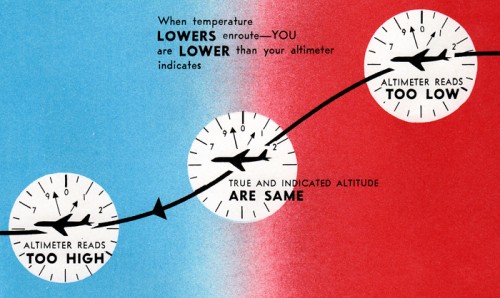I am a soon-to-be student-pilot and am struggling with a basic concept that is altitude. After watching multitude of online videos, I feel that most of the people do not have good teaching skills.
Introduction
The altimeter is a barometer, it reads atmospheric pressure. At 0' altitude, it should measure "this certain pressure that we find at 0'" and indicate 0'. This is obtained by setting the reference pressure in the Kollsman window measured somewhere near the airport. One day it might be 1013 hPa, others it will be 998 hPa or 1036 hPa.
The Scenarios
We are in the aeroplane, at the airport which is at MSL (0' altitude).
SCENARIO 1 (International Standard Atmosphere):
- Elevation: 0', temperature: 15 C, pressure: 1013.25 hPa
METAR reads
QNH 1013- we set our Kollsman window to 1013 => it correctly indicates 0' altitude
- we set it to less than 1013 =>
it will indicate more than 0' (say 230')LESS than 0'! - we set it to more than 1013 =>
it will indicate less than 0' (impossible but bear with me)MORE than 0'
SCENARIO 2 (low pressure):
- Elevation: 0', temperature: 15 C, pressure: 998 hPa
METAR reads
QNH 998- set our Kollsman window to 998 => it correctly indicates 0' altitude
- set it to less than 998 => it will indicate more than 0' (say 230')
- set it to more than 998 => it will indicate less than 0'
If I got the above correctly than the following should apply too:
SCENARIO 3 (International Standard Atmosphere):
Elevation: 5000', temperature: 5 C (as per lapse rate, -2C for every 1000'), pressure: 847 hPa (as per lapse rate, -1hPa every 30')
METAR reads
QNH 1013(actually our pressure of 847 hPa, adjusted down to MSL)- set our Kollsman window to 1013 => it correctly indicates 5000' altitude
- set it to less than 1013 => it will indicate more than 5000' (say 6200')
- set it to more than 1013 => it will indicate less than 5000'
My Questions
What happens at this altitude of 5000' if we move out of the ISA?
- if the temperature drops further to, say -2 C?
- if the pressure goes up to 900 hPa?
EDIT (answer):
My premise of "...we set it to less than 1013 => it will indicate more than 0' (say 230')" was wrong all the time! By setting the pressure in the Kollsman window we are effectively "telling" the altimeter at which pressure the 0' elevation is (or what is the pressure at 0' elevation).
If we "tell it" that the 0' is at 1000 hPa, and it is still sensing 1013 hPa as I initially stated, it will indicate only possible altitude - LESS than 0', not more.


